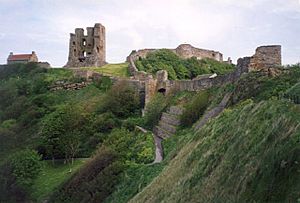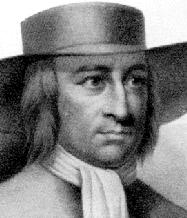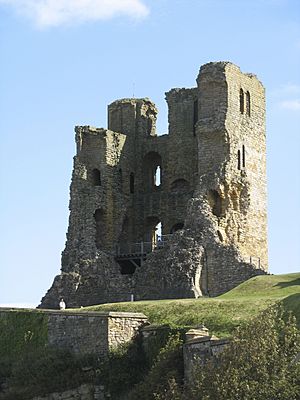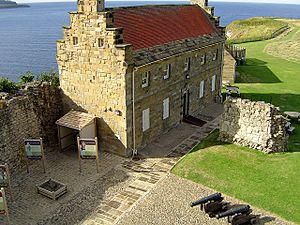Scarborough Castle facts for kids
Quick facts for kids Scarborough Castle |
|
|---|---|
| Part of North Yorkshire | |
| Scarborough, England | |

The keep and curtain wall
|
|
| Coordinates | 54°17′13″N 0°23′17″W / 54.287°N 0.388°W |
| Height | 49 feet (15 m) |
| Site information | |
| Owner | The Crown |
| Controlled by | English Heritage |
| Condition | Ruinous |
| Site history | |
| Built | 12th century |
| Built by | William le Gros |
| In use | Public access |
| Materials | Limestone Sandstone |
| Events | English Civil War |
Scarborough Castle is an old royal fortress located on a rocky piece of land that sticks out into the North Sea. It overlooks the town of Scarborough in North Yorkshire, England. This important historical site includes an old Iron Age settlement, a Roman lookout tower, an Anglo-Scandinavian village and church, the 12th-century stone castle, and an 18th-century gun battery. It is a protected national monument.
A wooden castle was first built here in the 1130s. The stone castle we see today was started in the 1150s. Over many years, more buildings were added. Kings spent a lot of money on this fortress because it was important. It protected the Yorkshire coast, Scarborough's busy port, and northern England from attacks by Scottish or European armies.
The castle was used and defended during many civil wars, sieges, and fights. Kings battled against powerful barons, faced rebellions, and fought against republican forces. After peace with Scotland and the end of civil wars in the 1600s, the castle became less important.
Once, soldiers and governors lived here, sometimes causing trouble for the town. The castle has been a ruin since the sieges of the English Civil War. Today, many visitors come to explore the old walls, enjoy the views, and learn about its history through exhibitions and special events run by English Heritage.
Contents
History of Scarborough Castle
Early Times at the Castle Site
Digs by archaeologists in the 1920s found proof that a hill fort was built on this headland. This fort was used between 900 and 500 BC, during the late Bronze Age and early Iron Age. Among the old items found, a Bronze Age sword, thought to be a special offering, is now on display. It is about 3,000 years old.
A Roman lookout tower was built on the cliff top in the 4th century. This was one of several such towers along the Yorkshire coast. Its job was to warn of enemy ships coming. The Romans used a natural spring of fresh water, which later became known as the "Well of Our Lady." The remains of the tower show it was square, with a small courtyard, and measured about 33 meters across. It was made of wood on stone foundations, with a gatehouse and an outer ditch.
Around the year 1000, the Anglo-Saxons built a small church on the site of the Roman tower. You can still see its remains today. People say this church was destroyed during the invasion by Harald Hardrada in 1066. An old Icelandic poem claims that Viking village near the harbor was burned down by Hardrada's forces in 1066. They supposedly built a huge bonfire on the headland to throw burning wood at the villagers. However, archaeologists have not found any proof of this event or of a Viking presence. The first signs of a harbor village appeared when the stone castle was built around 1157–1164. This village grew from a smaller settlement around the wooden fort that the stone castle replaced.
Piers Gaveston's Siege in 1312
Henry de Percy lived in the castle from 1308. He had a bakehouse, brewhouse, and kitchens built inside the castle walls. This made the castle a very strong fortress again. King Edward II (who ruled from 1307 to 1327) held some of his Scottish enemies there in 1311. In 1312, he gave the castles of Bamburgh and Scarborough to Isabella de Vesci.
The king's favorite knight, Piers Gaveston from Gascony, came to Scarborough Castle for safety. He was being chased by powerful barons who had created the Ordinances of 1311. These Ordinances were rules to limit the king's power, and the barons saw Gaveston as a threat. Sir Robert Felton was governor of Scarborough Castle in 1311. He was killed in a battle in 1314.
In April 1312, King Edward made Gaveston the governor of Scarborough Castle. But his time there was short. In May, the Earls of Pembroke and Warenne, along with Henry de Percy, attacked and captured the castle. Even though it had strong defenses, it fell quickly because it ran out of food. Gaveston was promised safe travel from the castle. But on his journey south, he was captured by the Earl of Warwick and killed. Scarborough town also suffered. King Edward punished the town for not helping Gaveston by taking away its special royal rights. He placed it under the direct rule of governors he chose.
Attacks and Decline: 1318–1635
During the Hundred Years' War (1337–1453), Scarborough was an important port for trading wool. Because of this, enemy forces attacked it several times. In 1393, with rumors of a French invasion, an investigation into the castle's condition led to repairs in 1396 and 1400. King Henry VI (who ruled from 1422–1461 and 1470–1471) ordered major repairs between 1424 and 1429.
Richard III (who ruled from 1483–1485) was the last king to visit the castle. He stayed there in 1484 while building a fleet to fight the Tudors. He lost this fight and his life the next year.
After attacks by forces from France and Scotland in the early 1500s, Robert Aske tried to take the castle in 1536. This was during the Pilgrimage of Grace, a rebellion against King Henry VIII (who ruled from 1509–1547). The rebellion was against the closing of monasteries and Henry VIII's break with the Roman Catholic Church. Aske's attempt to take the castle failed.
Repairs were made in 1537. In 1538, the castle keeper, Sir Ralph Eure, used some of the lead from the towers to make a brewing pot. Eure reported that some of the walls had fallen down. In 1557, forces loyal to Thomas Wyatt the younger took the castle. They were against Queen Mary I (who ruled from 1553–1558) and Catholicism. They entered the castle disguised as peasants. Their leader, Thomas Stafford, held the castle for three days. He was later executed for treason.
Civil War Sieges: 1642–1648
In September 1642, when the English Civil War (1642–1651) began, Sir Hugh Cholmley took control of the castle. He was a Parliamentarian loyal to Oliver Cromwell. But in March 1643, he switched sides to support the King. Cholmley ordered the castle to be made stronger, including building the South Steel Battery for cannons. After Cholmley changed sides, the castle, with its 700 Royalist soldiers, the town, and its important port, were on the side of King Charles I (who ruled from 1625–1649). The Parliamentarians saw Scarborough as a valuable target because it was the only port not under their control.
On February 18, 1645, Sir John Meldrum captured the town from the Royalists. This cut off any escape routes by land or sea and gave the port to Parliament. On the same day, Cholmley retreated into the castle and refused to surrender. So, the Parliamentarians prepared for a five-month siege. This was one of the bloodiest sieges of the Civil War, with almost constant fighting.
The Parliamentary forces set up the largest cannon in the country at that time, called the Cannon Royal. It was placed in the 12th-century St. Mary's Church below the castle. They fired 56–65 pounds (25–29 kg) cannonballs that hit the castle's defenses hard. In return, the church was badly damaged over three days of fighting. The bombing partly destroyed the castle keep, but the outer walls were not broken through. The Parliamentary forces could not take the castle. Then there was a period of very bloody hand-to-hand fighting around the barbican gateway, where Sir John Meldrum was killed.
By July, things were looking better for the Parliamentarians. Constant bombing, scurvy, lack of water, perhaps not enough gunpowder, and the threat of starvation meant that only 25 men were fit to fight. The castle surrendered on July 25, 1645. Only about half of the original 500 defenders were still alive. After this, the castle was repaired and rearmed for Parliament with 160 soldiers.
Matthew Boynton, the castle's new governor, declared for the king on July 27, 1648, because the soldiers were not being paid. This led to a second siege. The castle came back under Parliamentary control on December 19. The soldiers were defeated as much by the coming winter as by the Parliamentary forces. The castle changed hands seven times between 1642 and 1648. The castle was later used as a prison for those seen as enemies of the Commonwealth of England. This was a short time when England was a republic. The shell of the keep still stands, but its west wall was destroyed in the bombing. The castle was given back to the Crown when the monarchy was restored in 1660.
From 1660 Onwards
The castle was used as a prison from the 1650s. The number of soldiers living there increased in 1658. In 1662, it went back to being owned by the Crown. George Fox (1624–1691), who started the Religious Society of Friends (Quakers), was held prisoner there. He was imprisoned from April 1665 to September 1666 for his religious activities, which King Charles II (who ruled from 1660–1685) saw as troublesome.
The castle became less important again. King James II (who ruled from 1685–1688) did not keep soldiers there. He thought its defenses would be enough to stop any Dutch invasion. But the town was taken for William of Orange during the Glorious Revolution, which removed James from power.
The Jacobite Rebellion of 1745, which tried to put the Catholic House of Stuart back on the throne, led to the castle being made stronger again. By 1746, it had gun batteries and barracks for 120 officers and men. The keep was used to store gunpowder. The South Steel Battery was rebuilt. A barracks building with twelve rooms housed 120 soldiers. Three batteries were built to protect the town and harbor. Two faced south, and one was on the north side of the castle yard. In 1748, the Master Gunner's house was built. It was used as living quarters until the early 1900s. Today, it holds the castle's exhibition. The castle did not see any fighting during this time.
Later, the threat of French invasion during the Napoleonic Wars meant that soldiers were permanently stationed at the castle. This continued until the mid-1800s. French prisoners were held at the castle in 1796.
During the First World War, Scarborough was used for British propaganda. This happened after the bombing of the town by two warships from the German Empire. These were SMS Derfflinger and SMS Von der Tann on December 16, 1914. The attack killed 19 people and damaged the castle's keep, barracks, and outer walls. The castle was badly damaged by about 500 shells aimed at it and the town. The barracks were torn down because of the huge damage from the bombing. In the Second World War, the castle was used as a secret listening post.
Features of Scarborough Castle
The castle's location is naturally good for defense. It is on a headland with steep cliffs, 300 feet (91 m) high, on three sides facing the sea. The headland is connected to the mainland by a narrow strip of land. Here, a ditch or moat was dug, and a wall or fence with a gatehouse was built on the southwest land side. The stone curtain wall was built in the late 12th and early 13th centuries. It was made stronger by adding twelve round towers along its 230 yards (210 m) length. This wall does not go around all the inner buildings of the castle.
The entrance has a barbican, which is a strong fortification to protect the gateway. It was finished in the 14th century and has two half-circular towers on high ground. Changes to the barbican have removed signs of a portcullis (a heavy gate) and its grooves. The barbican stands where a 12th-century fortification was built, close to the remains of an 11th-century Anglo-Saxon church.
Beyond the main gateway, a stone bridge leads to the baileys or courtyards. This bridge was built between 1337 and 1338, replacing two drawbridges. It leads to the inner bailey, which was used for workshops, offices, a kitchen, and storage. Usually, a castle's inner bailey is reached through the outer bailey. However, at Scarborough, it's the other way around.
The 86-foot-tall (26 m) 12th-century keep and the castle's 150-foot-deep (46 m) well are inside the inner bailey. The keep, with its entrance on the first floor, is now just a shell. Its west wall, inside floors, and roof are missing because of the bombing in the 1600s. This square, four-story building was over 100-foot-tall (30 m), with a sloping base to help defense, a flat roof, and four turrets. Its walls are 11 to 15 feet (3.4 to 4.6 m) thick, with the west wall being the strongest. There are several windows, some of which are now blocked up. The corners have decorative rounded shapes.
On the first floor, there are remains of a hearth (fireplace) in the west wall. This floor was one large Great Hall, where people ate and often slept. The second and third floors were each divided into two rooms for important visitors or the governor. The basement was used for storage. Surveys in the late 1900s of the inner bailey have found the outlines of more 12th-century buildings.
The baileys are separated by a stone wall, a ditch, and a bank, with two defended gateways. The larger outer bailey would have been used for events, growing vegetables, and keeping animals. There was a graveyard and St. Mary's Chapel, which has completely disappeared. However, the remains of the old Anglo-Saxon chapel, on the site of an old Roman lookout tower, can still be seen. A 12th-century medieval building, 100 feet (30 m) long, stood in the outer bailey. It was for royal visitors and had a long hall, a private room with a fireplace for the monarch, and rooms for preparing and storing food. This building was torn down before a survey in 1538, which does not mention it. Only its foundations, found in 1888, remain.
In the outer bailey, a building called the "King's Chambers" or Mosdale Hall shows how the castle has changed over time. It was named after a 14th-century governor who improved it. This two-story building, next to the curtain wall, was originally built in the 13th century and updated after 1397. It was changed into red-brick barracks in the 18th century. After being badly damaged by German shelling in 1914, the building was torn down. You can clearly see the red brickwork next to the much older outer stone wall from Scarborough's South Bay.
The 13th-century Queen's Tower, in the nearby wall, also had different uses. At first, it was a fancy place to live with private latrines, a porch, and large windows with bay views. In 1320, two of these windows were blocked up, and one was changed into a cupboard with a rubbish chute. The Master Gunner's House, built in 1748, was used as living quarters until the last caretaker, Hudson Rewcroft, retired in 1965. His nephew, Ted Temple, shared his story of being the last person to live in The Master Gunner's House in the Scarborough Review, June 2017, page 12.
Important Governors
- 1270–: Geoffrey de Neville
- 1311–: Sir Robert de Felton (killed in battle, 1314)
- 1312: Piers Gaveston, 1st Earl of Cornwall (killed, 1312)
- 1312–: Isabella de Beaumont (died 1334)
- 1322–: Henry de Percy, 2nd Baron Percy
- 1537–: Sir Ralph Eure (died 1545)
- 1644–1645: Sir Hugh Cholmeley (Royalist)
- 1645–: Sir Matthew Boynton (died 1647) (Parliamentarian)
- 1648–: Colonel Matthew Boynton (Parliamentarian who became a Royalist) (killed in battle, 1651)
- c.1729: William Thomson
- c.1791: Hugh Palliser
- 1796–: Henry Phipps, 1st Earl of Mulgrave
Images for kids
-
Henry II was responsible for much of the original stone buildings of the castle; he began the work in the 1150s, and it cost him £682.
See also
 In Spanish: Castillo de Scarborough para niños
In Spanish: Castillo de Scarborough para niños






